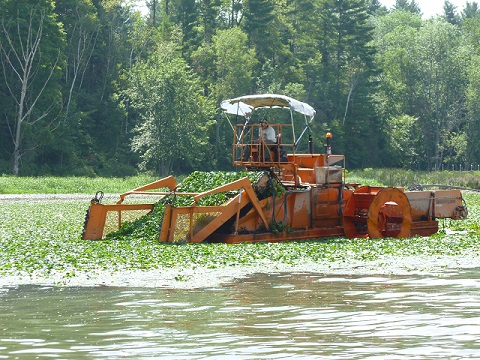Various aquatic invasive species (AIS) control efforts have been implemented in Vermont, and many are ongoing. DEC Aquatic Nuisance Control permits are available for local municipalities, watershed and lake associations, and other individuals who are involved in a myriad of control efforts around the state. The DEC AIS Program responds to early detection and rapid response events when new AIS introductions are found but does not typically manage AIS statewide, with the exception of Water chestnut (Trapa natans).
 Water Chestnut (Trapa natans) Management & Control
Water Chestnut (Trapa natans) Management & Control
Water chestnut (Trapa natans) is the only AIS species that is managed and controlled by DEC, through the AIS Program whereby contractors, staff, and volunteers work in partnership through a variety of local, state, federal, and NGO partners. Both mechanical and hand harvesting methods are used to significantly reduce the negative impacts of this invasive plant in Lake Champlain and other waters in Vermont, and to prevent further spread. Mechanical harvesting targets dense mats and is currently necessary only in southern Lake Champlain. Handpulling continues to be the main control method used at all sites. Notable progress in reducing water  chestnut populations has been made since efforts began in 1982. Most significant is a reduction of the Lake Champlain population; dense mats have been reduced from Ferrisburgh south to Benson. Many partners contribute to water chestnut control success in Vermont: The Nature Conservancy Vermont Chapter, U.S. Fish and Wildlife Service, Friends of Missisquoi Refuge and the Lake Champlain Basin Program among others.
chestnut populations has been made since efforts began in 1982. Most significant is a reduction of the Lake Champlain population; dense mats have been reduced from Ferrisburgh south to Benson. Many partners contribute to water chestnut control success in Vermont: The Nature Conservancy Vermont Chapter, U.S. Fish and Wildlife Service, Friends of Missisquoi Refuge and the Lake Champlain Basin Program among others.
Lake Champlain Water Chestnut Management Program
The DEC AIS Program oversees the operations for the Lake Champlain Water Chestnut Management Program in partnership with the U.S. Army Corps of Engineers, Lake Champlain Basin Program, and New York Department of Environmental Conservation. In 2024, the forty-year program was reviewed and the technical report and story map are available below. Funds for water chestnut management are appropriated from both federal and state sources.
Lake Champlain Water Chestnut Management Program Case Study Report
Lake_Champlain_Water_Chestnut_Management_Technical_Report_2024.pdf
Lake Champlain Water Chestnut Management Program Story Map
https://storymaps.arcgis.com/stories/409a1e75c0044010bc876ca1f00f344d
Eurasian Watermilfoil (Myriophyllum spicatum) Control
The majority of Eurasian watermilfoil (Myriophyllum spicatum) management in Vermont is borne by local entities, who dedicate considerable resources annually to manage this species. DEC provides technical assistance and assists partners where new introductions are found through the AIS Program's early detection and repaid response efforts. Control methods that may be permitted include mechanical methods (mechanical harvesting, diver operated suction harvesting), physical methods (benthic mats) and chemical treatments. Permits on notice for public comment can be found on the Vermont Environmental Notice Bulletin. Projects designed to manage or control Eurasian watermilfoil and other aquatic nuisance species are eligible for funding through DEC's Aquatic Nuisance Control Grant-in-Aid Program, and many towns use this grant opportunity to help fund Eurasian watermilfoil management projects annually.
